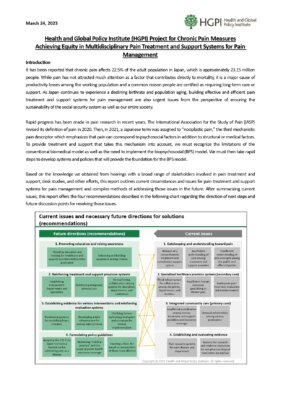[Policy Recommendations] Achieving Equity in Multidisciplinary Pain Treatment and Support Systems for Pain Management (March 31, 2023)
Today, the Health and Global Policy Institute (HGPI) Project for Chronic Pain Measures has presented policy recommendations titled, “Achieving Equity in Multidisciplinary Pain Treatment and Support Systems for Pain Management.” These recommendations are based on findings from desk studies and interviews with people living with chronic pain, healthcare providers, academia, and specialists in related fields. For more details, please find the PDF document attached at the bottom.
It has been reported that chronic pain affects 22.5% of the adult population in Japan, which is approximately 23.15 million people. And it has been estimated that chronic pain costs the Japanese economy approximately 2 trillion yen per year, mostly due to economic losses from the impact of chronic pain on the working population. Among elderly people, there are many cases in which people are certified as requiring long-term care or support due to chronic joint diseases. As Japan transitions to a super-aging society and begins to face tighter conditions surrounding social security funding and personnel shortages in healthcare and long-term care, the need to advance measures for chronic pain grows urgent.
In 2020, the International Association for the Study of Pain (IASP) revised its definition of pain for the first time in 41 years. The new definition emphasizes that pain does not always correspond to tissue damage, that it is highly personal, and that it is impacted by the emotions and experiences of the individual. In light of these characteristics, recent reports have shown that in addition to conventional, biological approaches, multidisciplinary interventions provided by various specialists based on the biopsychosocial (BPS) model can be effective for pain management. In Japan and a number of other countries, treatment guidelines for chronic pain recommend a wide range of interventions other than pharmacotherapy. These include educational interventions, psychotherapy, exercise therapy, and integrative medicine or complementary therapies like acupuncture and moxibustion, yoga, and meditation.
However, many of the interventions described by those guidelines are only available at a few facilities in Japan, such as the country’s 38 university hospitals that have been designated as “multidisciplinary pain centers.” Action must be taken to further promote said interventions, such as by ensuring multidisciplinary pain center operations are sustainable or through collaboration with community health services. Our policy recommendations summarize current issues related to pain treatment and support services and, based on those issues, outline steps that must be taken and discussion points that must be addressed to establish a system that rapidly delivers multidisciplinary treatment and support.
■ Overview of “Achieving Equity in Multidisciplinary Pain Treatment and Support Systems for Pain Management” policy recommendations
- Reinforcing education and awareness raising to foster public understanding toward concepts related to pain
1.1 Introduce education and training programs before and after graduation for all disciplines in health, medicine, and welfare as well as for healthcare-related private sector services
1.2 Reinforce education and awareness raising efforts that foster an appropriate understanding of pain among the public- Building systems that deliver specialized treatment and integrated care
2.1 Reinforce secondary care by creating independent departments that specialize in pain medicine, establishing a specialist certification, and training personnel to lead specialized treatment
2.2 Strengthen primary care through which parties most affected receive the integrated treatment and support they require by linking comprehensive care and consultation services with various community resources
2.3 Establish systems for collaboration across specialties, departments, facilities, and systems to provide a foundation for multidisciplinary treatment and support- Establishing a system that builds evidence for a broad variety interventions and rapidly disseminates them
3.1 Reinforce multidisciplinary research systems that conduct specialized research related to pain
3.2 Establish a data infrastructure to facilitate efforts to verify effectiveness for various interventions
3.3 Clarify methods of evaluating new human technologies as well as for completing processes like obtaining insurance coverage- Formulating policy guidelines that are based on the perspectives of those most affected to achieve equity when providing a broad range of evidence-based interventions
4.1 Adopt the eleventh revision of the International Classification of Diseases (ICD-11) in a timely manner and build a foundation for reinforcing treatment and support systems that address pain as a disease
4.2 Reconsider the definition of “medical practice” and the scope of benefits offered by public health insurance and establish systems that will serve as a foundation for implementing a biopsychosocial model that supports people living with chronic pain
4.3 Hold multi-stakeholder discussions and formulate a Basic Act on Chronic Pain that is based on the needs of people living with chronic pain
Hearing participants (titles omitted; in Japanese syllabary order)
Mariko Asaeda (Vice-Representative Director, the Goodbye Pain Patient Support Organization for Intractable Neuropathic Pain)
Masako Ikawa (Dental Surgeon, Department of Oral Surgery, Shizuoka City Shimizu Hospital)
Masako Iseki (Professor, Department of Anesthesiology and Pain Medicine, Juntendo University Faculty of Medicine)
Takahiro Ushida (Director and Professor, Multidisciplinary Pain Center and Institute of Physical Fitness, Sports Medicine and Rehabilitation, Aichi Medical University)
Fusao Kato (Director, Jikei Center for Neuroscience of Pain, The Jikei University School of Medicine)
Masaki Kitahara (Clinical Professor, Pain Clinic, Yokohama City University Medical Center)
Hironori Kuga (Director, National Center for Cognitive Behavior Therapy and Research, National Center of Neurology and Psychiatry)
Eriko Satomi (Chief, Department of Palliative Medicine, National Cancer Center Hospital)
Yumika Shirase (Professor, Graduate School of Social Sciences, Hitotsubashi University)
Takuya Numasawa (Director, Department of Orthopedic Surgery, Hachinohe City Hospital)
Sei Fukui (Clinical Professor, Pain Management Clinic, Shiga University of Medical Science Hospital)
Takako Matsubara (Professor, Graduate School of Rehabilitation, Kobe Gakuin University)
Koji Mori (Professor, Department of Occupational Health Practice and Management, University of Occupational and Environmental Health, Japan)
Shoji Yabuki (Professor, Endowed Chair, Department of Pain Medicine, Fukushima Medical University)
Kazuho Wakazono (Representative Director, the Goodbye Pain Patient Support Organization for Intractable Neuropathic Pain)
*Please note that these recommendations were compiled by independent health policy think-tank HGPI based on hearings and desk research. They should not be taken to represent the opinions of any specific advisory board member, any related party, or any organization to which those parties are affiliated.



